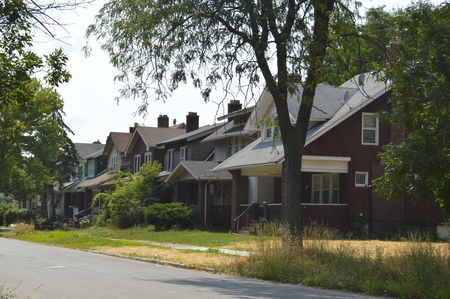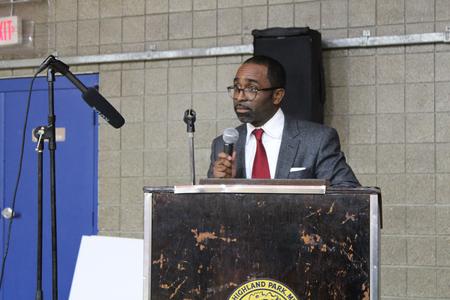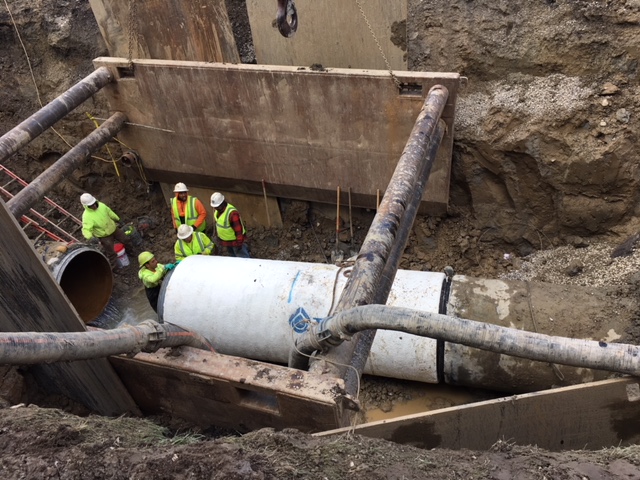Is My Water Safe to Drink? In Some Communities, There’s No Easy Answer
After the Flint Water Crisis, Michigan regulators instituted strictest-in-the-nation water quality standards. But that’s only the beginning for cities like Highland Park, which face public perception and funding challenges in replacing old infrastructure.

Marcia Cotton has lived in Highland Park for most of her life. She had her home tested for lead in her drinking water three times this year — but she doesn’t trust the city’s results.
Cotton said her first warning about her water quality came when she saw a letter hanging on her door this past spring but didn’t make much of it.
“There was no red flag,” Cotton says. “There was no emergency. It did not say, ‘Read this! Do not throw this away!’”
For her first two tests, she had trouble interpreting the results.
“At first I did not pay attention to the results. I saw it and I skimmed over it. And I looked at the first page and I saw” 6 parts-per-billion (ppb), a measurement for how many lead particles are found in the sample.
Resource: Ask WDET Questions About Highland Park Water Quality

On the second page of the testing results, it said 210 ppb, 14-times higher than the federal action level of 15 ppb. Michigan’s action level will drop to 12 ppb on January 1, 2025, making it the most stringent standard in the US. (The U.S. Environmental Protection Agency proposed updates to the federal Lead and Copper Rule last month that are less restrictive than Michigan’s).
Still concerned, Cotton had the city test her drinking water a third time. When the results came back for the third test, she was alarmed.
“It said I had a zero level of parts per billion, previously it said 210. All things the same, no repairs made,” Cotton says. “To go from six to 210 [parts per billion] to zero is just suspect testing.”
“If we’re not doing things, it’s not because we don’t have a desire or plan to do them, but because there’s a gap.” – Damon Garrett, Highland Park Water Department
Highland Park, a 2.9 square-mile city inside of Detroit, detected elevated levels of lead in drinking water in nine out of 36 homes this past summer, leading to months of concern and confusion. The city offers one case of the challenges facing low-income municipalities under the newly revised regulations, including an underfunded mandate to replace lead pipes and failure to explain the significance of testing results.
“We’re doing everything we can with what we have, and we’re not sitting idle,” says Highland Park Water Department Director Damon Garrett. “If we’re not doing things, it’s not because we don’t have a desire or plan to do them, but because there’s a gap.”

Strict Standards Meets Aging Infrastructure
Low-income communities such as Highland Park may be more vulnerable to environmental health hazards and lack of enforcement protections, research shows.
In the aftermath of the Flint Water Crisis, Michigan revised the state’s Lead and Copper Rule, implementing strictest-in-the-nation procedures to detect lead in drinking water and replace lead service lines in order to protect public health. Water utilities are tasked with implementing the new rules, while Michigan’s Department of Environment, Great Lakes and Energy (EGLE) must enforce them.
Explainer: Here are the changes to Michigan’s Lead and Copper Rule.
The new rule has triggered over 20 lead-in-water alerts across the state so far. Many testing results for water systems, including Detroit’s, are still being reviewed. But for low-income cities like Highland Park, the elevated levels alert is just one step in a long process.
Mixed Messages, Public Confusion
There are certain variables that explain why Cotton’s testing results were so drastically different.
Cotton’s first two samples were taken after the conduction of an emergency partial lead service line replacement. During this process, particles of lead can break off from the coating of the pipe, especially if there’s a lot of construction activity in the area, which can lead to a high result.
Nick Leonard is the Executive Director of the Great Lakes Environmental Law Center. He says a variety of factors can cause confusion, but points to different testing regimens by municipal water authorities as one big source.
Water utilities are required to use compliance sampling to determine whether a lead action level is justified. This testing is designed to measure the amount of lead in a water system, and requires that utilities sample both first and fifth liter of running water from homes and buildings with lead service lines or lead plumbing. Municipalities use these results to determine the effectiveness of corrosion control methods, and it is not intended to reflect how safe it is to drink water. There is no safe level of lead in drinking water.
“Not being able to know what concentrations of lead is coming out of the water [is a] really scary thing.” – Nick Leonard, Great Lakes Environmental Law Center.
Leonard says if a water system goes over the action level, they must offer residents a second test utilizing investigatory sampling, a different methodology that does not have to comply with the new Lead and Copper Rule. Michigan EGLE said in a statement that investigatory sampling can help “understand the condition of the system, what practices are working, and what areas of the system require additional focus.”

For Highland Park, Garrett says under the second round of testing, the department used smaller bottles and did not take fifth-liter samples in order to discover if the source of lead was in-home plumbing for the affected houses. He says that since the city’s infrastructure is so old, it is most likely that the majority of homes do have lead service lines, so the department judged that sampling fifth-liter results was unnecessary.
But not communicating the differences between testing methods and the information they yield can create a common point of confusion for residents, Leonard says.
“It puts them in a situation of not being able to know what concentrations of lead is coming out of the water. And that’s a really scary thing,” he says.
So Cotton’s dramatically different test results could be a factor of different testing methods, leading to her initial confusion and mistrust. Highland Park’s Garrett says this was unintentional.
“The purpose of doing that testing was not to mirror the [compliance] testing. We wanted to create a different data set about [in home] plumbing,” Garrett says.
“Highland Park has many challenges and has many water mains that must be replaced to keep the water infrastructure working for the entire community.” – Elin Betanzo, water expert
Funding Shortfalls
Communicating test results is just one issue the city is dealing with. Another is the sheer cost and coordination of replacing lead service lines.
EGLE has found that demand for infrastructure funding has increased as a result of the Lead and Copper Rule revisions. Under the new Lead and Copper Rule, water utilities must work to identify and replace all lead service lines within 20 years at an average rate of 5 percent a year, or, if they go over the action level, they are then required to replace lead service lines at 7 percent a year. All lead service lines must be replaced on both the public and private sides of homes.
But funding has not kept pace with the level of repairs needed, Garrett says. The $20 million dollars awarded to Highland Park for water system and sewer projects falls short of the original $100 million dollars requested for a complete system overhaul.
Funding shortfalls can push utilities to attack the problem piece-meal, causing further issues.

For instance, the first two samples collected from Cotton’s house were after a partial lead service line replacement, a method where the public side of water lines are replaced but residential property pipes are left unchanged, which can actually increase the amount of lead released into the home’s drinking water in the short term.
Partial lead service line replacement used to be the standard practice in Michigan and across the country, according to Elin Betanzo, a water expert and former EPA worker. The public health risk these replacements pose led regulators to ban partial lead service line replacements.
However, there are exceptions, including in the case of an emergency repair, such as a line break. Highland Park water authorities have performed more than 100 partial lead service line replacements to date using plastic pipes, according to Garrett. He says that Michigan environmental regulators were aware that these partial service line replacements were performed.
Betanzo says complete lead service line replacements are preferable, but recognizes the obstacles the community faces.
“Highland Park has many challenges and has many water mains that must be replaced to keep the water infrastructure working for the entire community,” says Betanzo. “There may have been circumstances where choices had to be made about which risks could be mitigated first,” she says.
“If someone is willing to step in and fill in that gap, federal, state or somewhere else, we can make quicker progress. Everyone is in it together,” – Damon Garrett, Highland Park Water Department
EGLE says they are continuing to work with Highland Park city officials “on developing a path forward to ensure that service line replacements are done in a transparent manner that informs the residents of potential issues and address concerns regarding lead exposure as a result of the replacement efforts.”
Garrett says the city plans to return to homes to complete replacing the remainder of the service lines on the private side, utilizing loans granted to the city from the state, which would likely result in a rate increase.
“If someone is willing to step in and fill in that gap, federal, state or somewhere else, we can make quicker progress,” Garrett says. “Everyone is in it together.”
But that’s little comfort for Cotton, who says she will have her water tested a fourth time by an independent lab. She needs to know, unequivocally, if her water is safe.
“I might want to rent out my home one day to a family that has small children or grandchildren. That’s my home,” she says.
Support the news you love.
Here at WDET, we strive to make our journalism accessible to everyone. As a public media institution, we maintain our journalistic integrity through independent support from readers like you. If you value WDET as your source of news, music, and conversation, please consider making a gift today. Even $5 a month helps!

